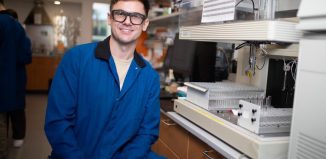SBU scientists work to restore balance of nature
Shinnecock Bay gets help from Christopher Gobler, Ellen Pikitch and their team
Christopher Gobler is tired of being the bearer of bad news for Shinnecock Bay. Every time someone wants to talk about ecological problems in the bay, they reach out to the Stony Brook scientist for information.
Gobler finally has some good news to share. He and a team of scientists at Stony Brook received a $3 million grant from the Simons Foundation and a private donor to turn the tide in Shinnecock Bay. Through a five-year plan, Gobler and fellow scientist Ellen Pikitch are leading an effort to restore the water quality and improve conditions at Shinnecock Bay. They hope their efforts will allow the bay to sustain larger populations of shellfish and finfish.
“We’re trying to do something to improve and reverse the things that have happened in the bay,” Gobler offered.
The effort was funded by a philanthropic gift from the Laurie Landeau Foundation, matched by similar funds from the Simons Foundation.
The eastern-most lagoon along the South Shore estuary system, Shinnecock contains 9,000 acres of open water, salt marshes and intertidal flats.
The bay, which was once home to a thriving range of shellfish, has had a decline in water quality because of the run off of nutrients like nitrogen and phosphorous, especially from septic tanks. Researchers believe nitrogen loading and the absence of shellfish are the biggest contributors to toxic red and brown tides, Gobler said.
“Part of the problem is that there’s stuff going into the bay” that leads to algal blooms, he offered.
Shinnecock is a tale of two bays. On the eastern side, it’s still closer to the best of times, as ocean water flushes through every day. The west side, however, is suffering through closer to the worst of times, as nutrients introduced by human actions remain in the bay for over a week because of less active ocean cleansing.
Researchers at Stony Brook’s School of Atmospheric and Marine Sciences plan to turn that around. The first step involves restocking shellfish, which will filter the water, and replanting eelgrass beds. This will create habitats for juvenile fish, which can hide from predators.
Scientists will also bring seaweed into the bay, which will act as a sponge, taking out the nutrients that lead to these red and brown tides. The scientists will remove the seaweed once it has absorbed enough nutrients, and will bring in a fresh batch.
Researchers like Pikitch and Gobler will monitor the bay regularly.
“This will be a continual effort we will build on,” suggested Gobler, a graduate of Ward Melville High School who now lives in East Quogue with his wife Dianna Berry and their three primary school-aged children. “We’re starting out with hard clams and oysters.”
Pikitch has already started surveying fish throughout the bay and has found, as she expected, that there is a greater range of fish living in the eastern part of the bay, where the water quality is considerably better.
Pikitch expects improvements in water quality and an expansion of a healthy habitat throughout the bay to foster growth of a broad range of fish.
“As water quality improves and as eelgrass beds flourish, fish will be able to reproduce, hide from predators, and grow,” she suggested.
Stony Brook University President Samuel Stanley hopes the restoration effort will “serve as a template for similar projects worldwide,” he said in a statement.
Those interested in learning more about the restoration program can visit the website www.shinnecockbay.org.
Pikitch, who lives in East Quogue, said one of her favorite activities is to take her grandchildren to the ocean, where she hopes they fall in love with it at an early age, the way she did.
“I worry about what kind of world my grandchildren will grow up in,” she offered. “I worry about harmful algal blooms. I wonder: What if we didn’t do anything and things got worse.”
If, she added, “the bays aren’t healthy, we won’t be healthy.”
She said she feels a sense of urgency about her work. After all, humans caused the problem and we should be able to turn it around, she offered.
“We’re going to make a big dent,” she predicted. “This is a problem that can be solved.”






